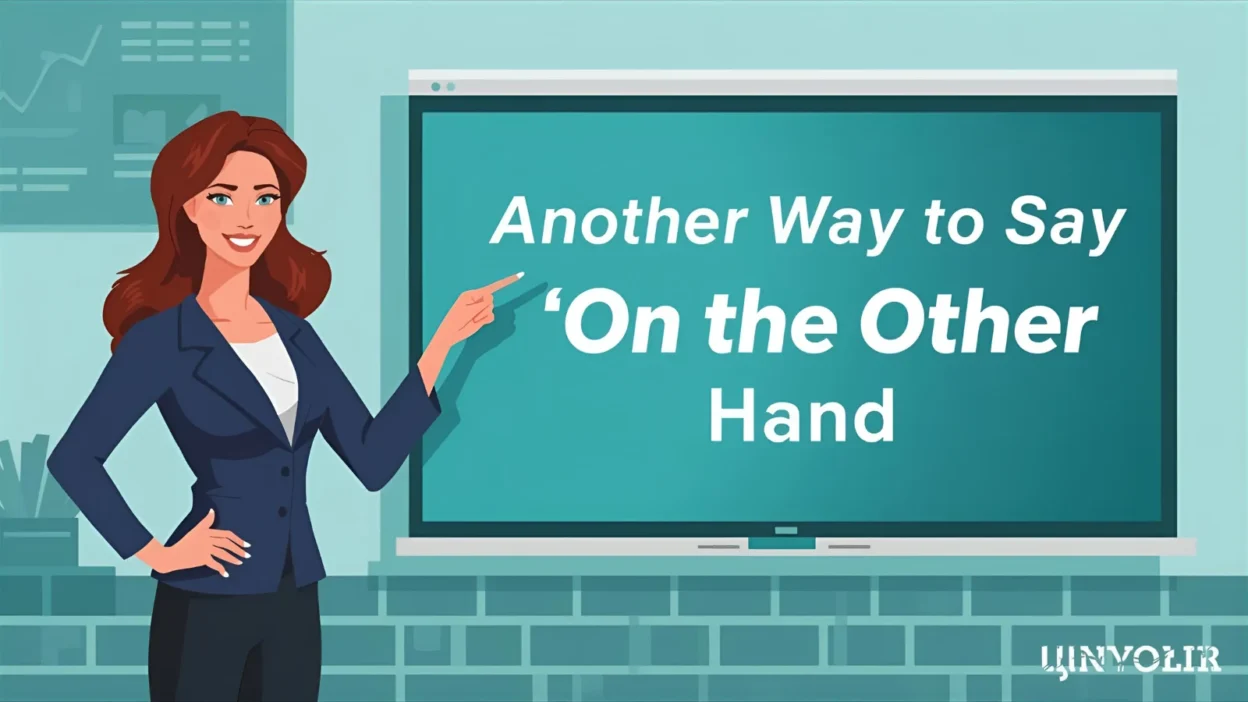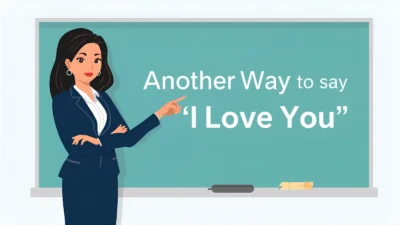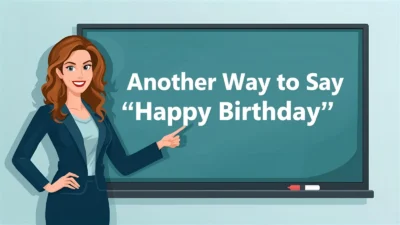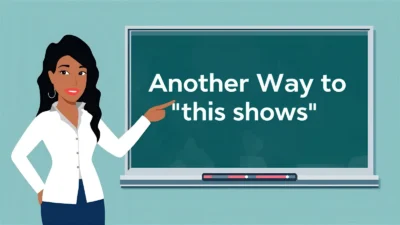The phrase “on the other hand” is widely used to present contrast, show an alternative perspective, or weigh pros and cons. While clear and effective, overusing it can make your writing or speech sound repetitive or predictable. Fortunately, there are many alternatives that can express contrast with different levels of formality, nuance, and tone.
In this article, you’ll discover 25 alternatives to “on the other hand,” each explained with meaning, usage, examples, best context, and tone. Whether you’re writing an essay, giving a presentation, or simply having a thoughtful discussion, these expressions will help you present contrasting ideas more effectively.
1. Conversely
Meaning: Indicates the opposite of the previous statement.
Detailed Explanation: Strong formal choice, often used in academic and analytical writing.
Scenario Example: Remote work improves flexibility. Conversely, it may reduce team bonding.
Best Use: Essays, research, professional reports.
Tone: Formal, precise.
2. In Contrast
Meaning: Highlights a clear difference between two ideas.
Detailed Explanation: Direct and simple way to show opposition.
Scenario Example: The north experiences heavy rainfall. In contrast, the south remains dry.
Best Use: Academic writing, business reports.
Tone: Neutral, formal.
3. Alternatively
Meaning: Presents a different option or possibility.
Detailed Explanation: Useful when offering choices rather than direct opposites.
Scenario Example: We can extend the deadline. Alternatively, we can assign more staff to finish earlier.
Best Use: Business, proposals, formal and informal writing.
Tone: Professional, flexible.
4. By Comparison
Meaning: Shows how two things differ when examined side by side.
Detailed Explanation: Often used to highlight contrasts in qualities or results.
Scenario Example: The new model is faster. By comparison, the old one feels outdated.
Best Use: Reviews, reports, essays.
Tone: Analytical, neutral.
5. Whereas
Meaning: Connects two contrasting clauses in a single sentence.
Detailed Explanation: More formal than on the other hand, often used in academic or legal writing.
Scenario Example: She prefers fiction, whereas he enjoys non-fiction.
Best Use: Legal, academic, structured writing.
Tone: Formal, precise.
6. While
Meaning: Introduces a contrast in the same sentence.
Detailed Explanation: Shorter and more natural than on the other hand.
Scenario Example: While the plan is ambitious, it may not be realistic.
Best Use: General writing, essays, speeches.
Tone: Neutral, versatile.
7. Though
Meaning: A softer contrast, often conversational.
Detailed Explanation: Works well in informal speech and writing.
Scenario Example: The movie was too long. Good acting, though.
Best Use: Conversation, casual writing.
Tone: Casual, conversational.
8. Yet
Meaning: Expresses a surprising contrast.
Detailed Explanation: Often signals an unexpected opposition.
Scenario Example: He studied hard, yet he failed the exam.
Best Use: General writing, debates.
Tone: Neutral, slightly dramatic.
9. On the Flip Side
Meaning: Informal way to present the opposite perspective.
Detailed Explanation: Playful and conversational alternative.
Scenario Example: The job pays well. On the flip side, it’s very stressful.
Best Use: Casual writing, conversations, blogs.
Tone: Informal, friendly.
10. At the Same Time
Meaning: Balances two contrasting points simultaneously.
Detailed Explanation: Shows coexistence rather than strict opposition.
Scenario Example: The project is challenging. At the same time, it’s rewarding.
Best Use: Presentations, essays, balanced arguments.
Tone: Reflective, thoughtful.
11. Even So
Meaning: Introduces a counterpoint despite acknowledgment of the first idea.
Detailed Explanation: Useful for showing contrast while keeping the first point valid.
Scenario Example: The evidence is weak. Even so, the case moved forward.
Best Use: Debates, persuasive writing.
Tone: Thoughtful, slightly formal.
12. Still
Meaning: Suggests persistence of one idea despite another.
Detailed Explanation: Often emphasizes resilience or contradiction.
Scenario Example: He was tired. Still, he kept working late into the night.
Best Use: Essays, conversation, narrative writing.
Tone: Neutral, flexible.
13. All the Same
Meaning: Acknowledges a point but introduces a contrasting perspective.
Detailed Explanation: Slightly old-fashioned but effective in emphasis.
Scenario Example: It’s risky. All the same, it might be worth trying.
Best Use: Essays, discussions, reflective writing.
Tone: Neutral, reflective.
14. In Opposition
Meaning: Highlights direct contradiction.
Detailed Explanation: More formal, often used in structured debates or analysis.
Scenario Example: In opposition to his claim, data shows a downward trend.
Best Use: Academic, analytical writing.
Tone: Formal, strong.
15. But Then Again
Meaning: Adds a counter-thought, often informally.
Detailed Explanation: Works well when reconsidering or softening a statement.
Scenario Example: She seems unfriendly. But then again, she might just be shy.
Best Use: Casual speech, blogs, opinion pieces.
Tone: Conversational, reflective.
16. In Comparison
Meaning: Highlights contrast through differences.
Detailed Explanation: Similar to by comparison, but slightly more general.
Scenario Example: This year’s profits grew. In comparison, last year’s were flat.
Best Use: Reports, essays.
Tone: Analytical, neutral.
17. However
Meaning: Signals a contrast or contradiction.
Detailed Explanation: Formal and versatile, widely used in all types of writing.
Scenario Example: The offer is tempting. However, it comes with conditions.
Best Use: Academic, professional, general writing.
Tone: Formal, professional.
18. Inversely
Meaning: Shows an opposite relationship.
Detailed Explanation: Strongly analytical, often in technical contexts.
Scenario Example: Inversely, when supply increases, prices usually drop.
Best Use: Scientific, economic, technical writing.
Tone: Formal, analytical.
19. From Another Angle
Meaning: Introduces a different perspective.
Detailed Explanation: Suggests re-examining from a new viewpoint.
Scenario Example: From another angle, outsourcing could reduce costs.
Best Use: Analytical, business, creative writing.
Tone: Thoughtful, flexible.
20. Then Again
Meaning: Casual way of reconsidering or adding contrast.
Detailed Explanation: Less formal than however.
Scenario Example: It looks expensive. Then again, it might be worth the quality.
Best Use: Conversation, blogs, informal writing.
Tone: Casual, reflective.
21. On the Contrary
Meaning: Directly refutes or opposes a point.
Detailed Explanation: Stronger than on the other hand, used to reject rather than balance.
Scenario Example: It seems complicated. On the contrary, it’s quite simple.
Best Use: Debates, persuasive writing.
Tone: Assertive, formal.
22. Inversely Proportional
Meaning: Expresses a specific type of opposite relationship.
Detailed Explanation: Best for technical or scientific contexts.
Scenario Example: Speed is inversely proportional to travel time.
Best Use: Math, science, technical reports.
Tone: Technical, precise.
23. Looking at It Differently
Meaning: Encourages shifting perspective.
Detailed Explanation: Casual way to show contrast or new angle.
Scenario Example: Looking at it differently, the delay could help us prepare better.
Best Use: Informal discussions, coaching.
Tone: Friendly, thoughtful.
24. From the Other Side
Meaning: Emphasizes a viewpoint opposite to the first.
Detailed Explanation: Slightly more metaphorical.
Scenario Example: From the other side, automation may reduce job opportunities.
Best Use: Debates, essays, reflective writing.
Tone: Neutral, flexible.
25. Yet Again
Meaning: Adds another opposing factor or observation.
Detailed Explanation: Works when reinforcing a repeated contrast.
Scenario Example: The strategy worked last time. Yet again, circumstances are different now.
Best Use: Narrative, persuasive writing.
Tone: Neutral, flexible.
Conclusion
The phrase “on the other hand” is reliable, but variety makes your communication more dynamic and engaging. Depending on the context, you can choose formal options like “conversely” or “whereas,” casual ones like “on the flip side” or “but then again,” or analytical ones like “in contrast.” With these 25 alternatives, you’ll be able to present opposing viewpoints with precision, style, and clarity.



